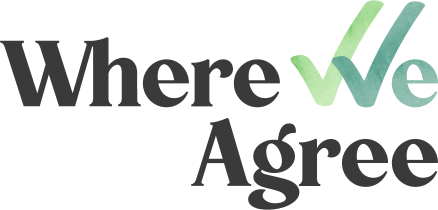Who is the “We” in Where We Agree?
The “We” in Where We Agree is the full set of people who shape, lead, work with, or rely on schools: teachers, students, families, paraprofessionals, principals, union leaders, district leaders, school board members, caregivers, researchers, advocates, nonprofit partners, community members, and more. The group is large, diverse, and full of complexity and disagreement. But it also agrees on a lot: that teachers are overburdened and underpaid; that the teaching profession should be rewarding, dynamic, collaborative, sustainable, and diverse; and that every student deserves equitable access to a quality education.
What do you mean by modern classroom?
Modern classrooms prepare students for success in a 21st century world. They do so by being flexible, iterative, and tailored to meet student contexts and needs, respond to an evolving research base about what works for students, and adapt to the conditions of a rapidly changing world. As one teacher put it, “A modern classroom is one that leans in to new areas of innovation as they emerge. It effectively leverages the new tools at its disposal to deliver accessible instruction for all students.”
How were the “associated principles” of the teaching profession developed?
In 2023, E4E was invited to participate in the Coalition to Reimagine the Teaching Role, a group of education and advocacy organizations working to create the conditions where all K-12 educators thrive in roles that are collaborative, diverse, dynamic, rewarding, and sustainable. E4E added one more principle for the purpose of this website: “student-centered.”
What is a teacher contract and what is a collective bargaining agreement–are they the same?
A teacher contract is a legally binding agreement between a teacher and a public school system. A collective bargaining agreement (or CBA) is one in which a contract is achieved through the process of collective bargaining. You will see “contract” or “teacher contract” throughout the site where we share example provisions from contracts. Our paper, “Designing Contracts for a Modern Classroom: The ABCs of CBAs,” dives into a framework for innovative CBAs: the content of the agreement, the bargaining process, and the collective group of stakeholders involved.
What methodology was used to find and evaluate contract language?
In the first phase of this work, TNTP and E4E partnered to conduct a systematic review of 50 contracts in the 41 states that do not prohibit or severely restrict bargaining. We started with districts we knew had contracts that were student-centered, democratic, helped districts attract and retain educators, promoted anti-racism, and allowed for innovation at the school level, then expanded our search nationally to include a wide sample, diverse with respect to geography, district size and student demographics. In the second phase of this work, E4E and the Center for Public Research and Leadership, or CPRL, at Columbia University partnered to conduct a systematic review of the academic literature on the issue; interview 84 leaders in the field; consult with an Advisory Council of 21 experts, including national and local union leaders; and ultimately review 41 teacher contracts identified via the desktop research and interviews. Finally, we added additional contract provisions that we were aware of but that had not been identified throughout the research process.
What is the role of federal and state law in teacher contracts?
Federal and state law set the stage for teacher contracts and collective bargaining. Together, they affect the boundaries of what is in employment contracts, their on-the-ground implementation and enforcement, and whether collective bargaining for public employees is allowed at all. See Designing Contracts for the Modern Classroom: The ABCs of CBAs for a deeper discussion of the role of federal and state law in teacher contracts.
Should I consider the information on this site “legal advice”?
This website does not offer legal advice, and none of its content should be understood to provide legal advice. If any question arises as to the legal implications of any action taken in connection with the activities discussed on this website, you are encouraged to consult local counsel for legal advice specific to the legal context in which your school system operates.
How is this work applicable to charter schools?
11.3% of charter schools were unionized as of 2019 (NACPS), and over half of unionized charters are subject to traditional collective bargaining agreements. Unionized or unionizing charters can find examples of contract language that enables a collaborative, dynamic, diverse, rewarding, sustainable, and student-centered profession in charter and district teacher’ contracts.
Where can I find more teacher contracts to review?
Visit the specific union’s website or the district’s website to find the current contract. Additionally, the National Council on Teacher Quality (NCTQ) Teacher Contract Database houses contracts from over 140 of the largest districts in all 50 states.
How do I know if something is bargained?
Start with consulting your local union representative and reading your local contract to know the scope of what your district and union have bargained for in your contract. State law will play a role in the scope of what is allowable for bargaining. Through our research, we have found that the issue areas included on this site–compensation, teacher leadership, teacher evaluation, layoffs, professional learning, student discipline, and school-based flexibility–are commonly, though not always bargained.

Email me these ideas for modern contracts.


